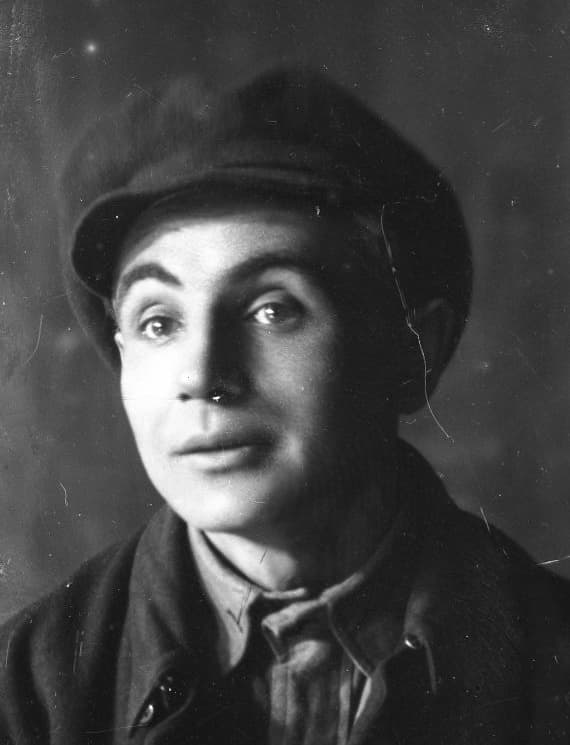Adaptation of Marko Kropyvnytskyi’s play by Volodymyr Yaroshenko
Script by Favst Lopatynskyi
Premier: November 8, 1924
Director: Favst Lopatynskyi
Member of Director’s Lab: I. Kryha
Artists: Valentyn Shkliaev, Maiia Symashkevych, Vadym Meller
Music: Leonid Entelis
Dance: Olena Kryvynska
Physical Trainer: I. Irok
Assistant Director: Oleksandr Savytskyi
Kuksa – F. Lopatynskyi, Yosyp Hirniak, M. Krushelnytskyi
Dranko – S. Shahaida
Oryshka – Z. Pihulovych, H. Babiivna
Horpyna – M. Marych
Anton – O. Ivashutych
Vasil – N. Ilchenko, M. Kononenko
Nechypir – P. Dolyna, A. Shutenko
Scribe – S. Karpenko
Circus staff:
L. Datsenko
B. Drobynskyi
P. Kovbasiuk
H. Lor
A. Maherovskyi
P. Masokha
T. Myrhorod
O. Pihulovych
O. Podorozhnyi
V. Stetsenko
S. Svashenko
They Made Fools of Themselves, based on Marko Kropyvnytskyi’s play, was Favst Lopatynskyi’s third directorial piece at the Berezil Artistic Association. In this production he continued his “clash with the author” – using an adaptation by Volodymyr Yaroshenko rather than the original text.
He kept all the storylines but the dialogue sparkled with jokes that reflected the times. Some critics welcomed this: “The political jabs scattered throughout the play are filled with deep meaning and references to the present. They are so well chosen and, more importantly, well placed in the old text that you don’t feel any tension from this element of the play.” Others cast doubt on the author’s literary skill and were categorically against such experiments, calling Yaroshenko’s adaptation a parody of Kropyvnytskyi’s play: “The play was adapted poorly and if you were to grade this adaptation it would deserve no more than a zero.”
The plot of Yaroshenko’s interpretation is close to the original. The main characters (mill owner Kuksa and smithy owner Dranko) are kurkuls who dream of marrying off their many daughters to worthy candidates, but they end up with their journeymen. Although the adaptation had some good parts, most critics at the time said it was somewhat artificial.
The response to Lopatynskyi’s directing among artistic audiences was very contrasting and provoked heated debates and discussions. Although it couldn’t be said that the play wasn’t original and colorful, it was called “worthless” and “unsuccessful.”
“The director turned Marko Kropyvnytskyi’s operetta into a circus spectacle,” wrote actor Yosyp Hirniak. The stage resembled a circus arena with all the trappings. The audience saw trapeze bars, safety nets and mattresses, and the characters looked like circus performers. (Valentyn Shkliaev, Maiia and Vadym Meller were the artists).
The main characters – Kuksa and Dranko – were dressed in clown outfits and performed circus stunts and acrobatics. The young couples in love (Vasyl and Horpyna and Anton and Oryshka) sang and spoke while flying from one trapeze to another. It took a lot of work for the actors to do the comedic stunts. Some of them were injured during rehearsals. Actor Oleksandr Serdiuk recalled: “The actors in They Made Fools of Themselves swung on [the trapeze], spun around the horizontal bars, jumped over pommel horses, fell, sprained their ankles, pulled their muscles.” Such was the fate of a Berezil actor, who was expected to master his body, voice and spirit. Kurbas made sure of this by introducing different kinds of classes and lectures at Berezil. Sofiia Fedortseva wrote: “Berezil is a theater that is constantly looking for new tools. To this end, the actor learns movement, song and even acrobatics.”
The actors wrote that they were given a lot of freedom in the play but had to stick to the director’s plan and rhythm. They were allowed to make verbal and physical improvisations without warning their partners in advance. Everyone was passionate about their work and came up with new surprises for their colleagues. Yosyp Hirniak recalled that one time he decided to use his dog Duke in the play and he handled the role so well that he played it through the end of the season.
He music was unusual: the director used Kropyvnytskyi’s original songs and music but added unexpected musical instruments. “On the left side of the arena there was a group of ‘circus attendants’ who were also the circus orchestra. They played combs, primitive pipes and different kinds of children’s rattles,” wrote Hirniak.
The play was remembered for its strong and colorful cast. Critics singled out Stepan Shahaida in the role of Dranko, Zinaida Pihulovych as Oryshka, Yosyp Hirniak and Marian Krushelnytskyi as Kuksa. For Krushelnytskyi the role of Kuksa was his debut at Berezil and a bright new page in his life.
Lopatynskyi’s take on the play was very original and left an impression on the audience, who were happy to become immersed in the circus element of a theatrical performance. The show was a box office hit. As modern theater critics point out, this work was an important stage in the organic circusification of theater.
Critics and supporters of Berezil were traditionally divided. Some reviewers, artists and cultural figures were in awe, while others were critical and had mixed opinions. Lopatynskyi himself was satisfied with the outcome. “There was fierce controversy surrounding the show, but ultimately it emerged victorious, gaining universal acclaim,” he wrote.

